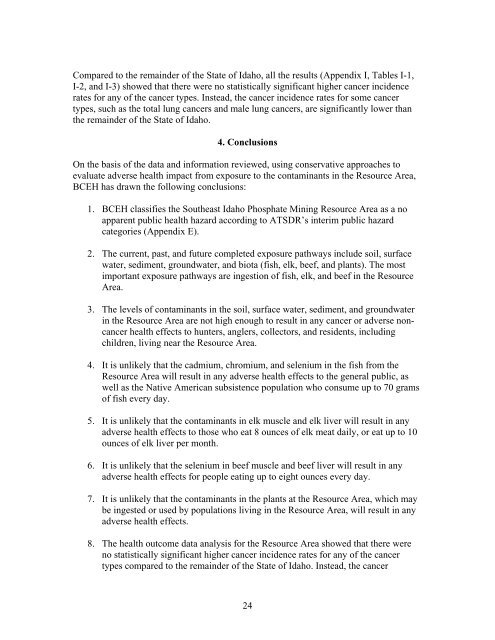Southeast Idaho Phosphate Mining Resource Area - Agency for ...
Southeast Idaho Phosphate Mining Resource Area - Agency for ...
Southeast Idaho Phosphate Mining Resource Area - Agency for ...
Create successful ePaper yourself
Turn your PDF publications into a flip-book with our unique Google optimized e-Paper software.
Compared to the remainder of the State of <strong>Idaho</strong>, all the results (Appendix I, Tables I-1,<br />
I-2, and I-3) showed that there were no statistically significant higher cancer incidence<br />
rates <strong>for</strong> any of the cancer types. Instead, the cancer incidence rates <strong>for</strong> some cancer<br />
types, such as the total lung cancers and male lung cancers, are significantly lower than<br />
the remainder of the State of <strong>Idaho</strong>.<br />
4. Conclusions<br />
On the basis of the data and in<strong>for</strong>mation reviewed, using conservative approaches to<br />
evaluate adverse health impact from exposure to the contaminants in the <strong>Resource</strong> <strong>Area</strong>,<br />
BCEH has drawn the following conclusions:<br />
1. BCEH classifies the <strong>Southeast</strong> <strong>Idaho</strong> <strong>Phosphate</strong> <strong>Mining</strong> <strong>Resource</strong> <strong>Area</strong> as a no<br />
apparent public health hazard according to ATSDR’s interim public hazard<br />
categories (Appendix E).<br />
2. The current, past, and future completed exposure pathways include soil, surface<br />
water, sediment, groundwater, and biota (fish, elk, beef, and plants). The most<br />
important exposure pathways are ingestion of fish, elk, and beef in the <strong>Resource</strong><br />
<strong>Area</strong>.<br />
3. The levels of contaminants in the soil, surface water, sediment, and groundwater<br />
in the <strong>Resource</strong> <strong>Area</strong> are not high enough to result in any cancer or adverse noncancer<br />
health effects to hunters, anglers, collectors, and residents, including<br />
children, living near the <strong>Resource</strong> <strong>Area</strong>.<br />
4. It is unlikely that the cadmium, chromium, and selenium in the fish from the<br />
<strong>Resource</strong> <strong>Area</strong> will result in any adverse health effects to the general public, as<br />
well as the Native American subsistence population who consume up to 70 grams<br />
of fish every day.<br />
5. It is unlikely that the contaminants in elk muscle and elk liver will result in any<br />
adverse health effects to those who eat 8 ounces of elk meat daily, or eat up to 10<br />
ounces of elk liver per month.<br />
6. It is unlikely that the selenium in beef muscle and beef liver will result in any<br />
adverse health effects <strong>for</strong> people eating up to eight ounces every day.<br />
7. It is unlikely that the contaminants in the plants at the <strong>Resource</strong> <strong>Area</strong>, which may<br />
be ingested or used by populations living in the <strong>Resource</strong> <strong>Area</strong>, will result in any<br />
adverse health effects.<br />
8. The health outcome data analysis <strong>for</strong> the <strong>Resource</strong> <strong>Area</strong> showed that there were<br />
no statistically significant higher cancer incidence rates <strong>for</strong> any of the cancer<br />
types compared to the remainder of the State of <strong>Idaho</strong>. Instead, the cancer<br />
24
















